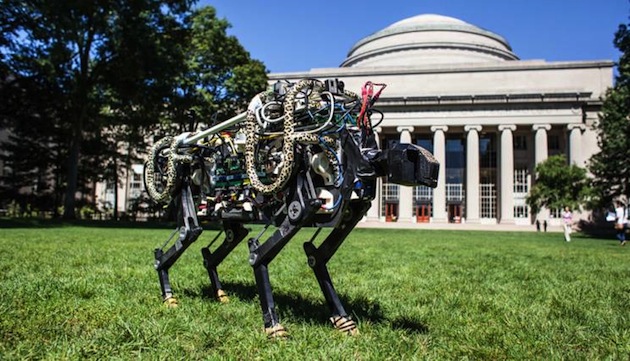
MIT improves its robo-cheetah by giving it the ability to bound and run around outside while untethered
 |
| This mechanical cheetah has learned some new tricks. |
Watch out...the cheetah-bot has evolved and it no longer needs a leash. MIT's big-cat-inspired robothas gotten some serious upgrades as researchers continue to improve its skills. It's come a long way since its first treadmill test, during which it was tethered up. It can now run free, and a new algorithm allows it to bound in a peppy manner while navigating the terrain of a grass lawn.
A demonstration video released by MIT shows the robo-cheetah running across grass and then bounding upward to demonstrate its new jumping skills. It can clear obstacles that are just over a foot high. MIT's cheetah is especially interesting due to its construction using custom-made electric motors. The motors have proven to be powerful enough to propel the robot forward and upward while still maintaining a light weight.
Sangbae Kim, an associate professor of mechanical engineering at MIT, compares the electric motors of the cheetah-bot to other heavier, louder quadruped robots that use gasoline motors. "Our robot can be silent and as efficient as animals. The only things you hear are the feet hitting the ground," he told MIT News. "This is kind of a new paradigm where we're controlling force in a highly dynamic situation. Any legged robot should be able to do this in the future."

The robo-cheetah is helping researchers gain a greater understanding of animal locomotion and how it can help robots move more efficiently. Future applications for the technology could appear in new transportation devices or in prosthetics designed for humans.
Real cheetahs can zoom along at 60 mph. The robo version from MIT can reach 10 mph, but the mechanics are in place to make it considerably faster. The researchers expect this version could hit 30 mph, which would put it much closer to thecheetah-bot made by Boston Dynamics, which is faster than champion sprinter Usain Bolt.
Future versions of MIT's robot could pull off even more impressive speeds, making it pretty much impossible for slow humans to outrun the inevitable robot revolt should we ever find ourselves in a suitably dystopian sci-fi future.
No comments :
Post a Comment